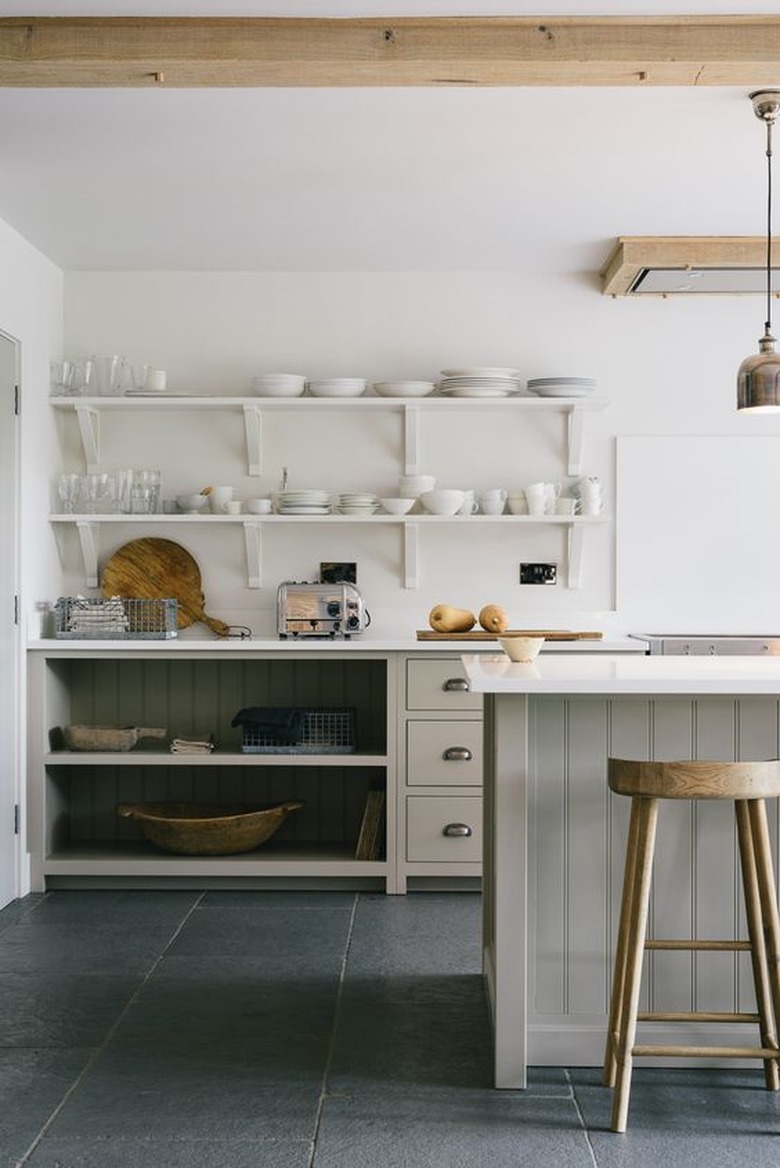It's Time To Consider Slate Kitchen Floors — Here's Why
Kitchen renovations are a big deal. And a large-scale project like that isn't something that you dive into willy-nilly. Sure, it's far from sexy, but research and planning are key steps in the remodeling process. Which brings us to slate kitchen floors. It's easy to see why folks love this natural stone (and we mean that quite literally). It has tons of rich texture and comes in a range of earthy hues — everything from charcoal and rust to olive and brown.
It's also sturdy, unfussy, and holds up well over the years. Needless to say, it's great for high-traffic areas such as the kitchen, bath, or mudroom. Beyond that, maintenance is a breeze. (After all, wouldn't you rather spend time actually enjoying your swanky cook space rather than constantly cleaning and refinishing the floors?) While slate tile is an excellent choice for the heart of your home, there are still some important things to consider before installing this sought-after material.
What Is Slate Flooring?
What Is Slate Flooring?
Let's start at the very beginning. For those who aren't familiar, slate is a metamorphic rock. Without getting too science-y, it's formed when heat or pressure is applied to mudstone or shale.
And, in case you were curious, slate happens to be the finest-grained foliated metamorphic rock. So, that's a fun fact to whip out at your next dinner party.
Pros
Slate is durable.
The way slate is forged has a lot to do with its durability. This hardy material can withstand the rigors of daily life, whether that involves enduring excessive foot traffic or handling the pressure of heavy bags of groceries being dropped on it. If you do chip or scratch slate, rest assured knowing it won't be as noticeable as if you had ceramic or porcelain tile.
It's low-maintenance.
Beyond being sturdy, slate kitchen floors don't show signs of regular wear and tear. The dark color and texture makes dirt, dust, and grime less apparent. And to clean slate, all you have to do is grab your trusty broom. Wondering what happens if you spill something like coffee or pasta sauce? Not to worry, stains can be easily removed — learn more here.
To ensure slate stays in peak condition for the long-haul, we'd advise giving it a good rub down with a neutral pH solution every couple of months and resealing it twice a year.
It comes in a wide variety of colors and textures.
You've likely seen charcoal-hued slate tiles — commonly rectangular or square — which work beautifully in contemporary, traditional, and farmhouse-style spaces. There are also more natural-looking options that display shade variations, ranging from rust and brown to tan and olive.
In terms of texture, you can opt for slate flooring that showcases innate surface characteristics —which lends a rustic feel and tends to be less slippery — or tile that has been sanded smooth.
Cons
It's pricey.
Slate kitchen floors aren't cheap. Depending on the type of stone, tile can range from $2 to $10 per square foot. And the cost of material isn't the only thing to think about: You'll need to budget for labor, too. Professional installation can up the price threefold. Intricate patterns, like herringbone and checkerboard, also mean writing a bigger check.
You could save money by turning it into a DIY project. But, consider yourself warned, it takes time, effort, and know-how — not to mention specialty tools — and isn't advisable for novice do-it-yourselfers.
There are structural considerations.
Because slate is heavy, it requires a fair amount of support. Thus, the subfloor and framing need to be in tip-top shape (aka structurally sound), otherwise, you might end up with cracked tiles. Who wants that?
It can be cold.
Slate kitchen floors can get very cold, especially during the winter months. Radiant floor heating systems are a smart way to warm things up, however, if that's not something your home already has, you're looking at an added expense. You could just decide to wear socks every time the temp drops, but that's probably not the most practical solution. A quick and wallet-friendly fix is to lay down a few area rugs.
